Winter can make our homes feel dull and empty. But, did you know a few colorful indoor houseplants can change that? They can add color, life, and energy to your space. Let’s look at 13 vibrant plants that can brighten up your home.
Have you ever seen those green, lively spots in your friends’ homes or online? Wondered how they keep them alive? The secret is simple: with the right care, these plants can thrive indoors. They bring color and beauty, making your home look better and making you feel happier. Let’s find out which plants will make your home cheerful and inspiring all year.
Table of Contents
1. Anthurium (Flamingo Flower)
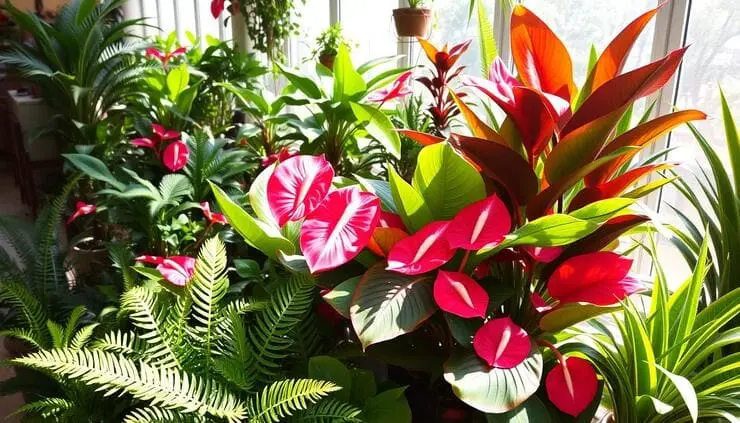
The anthurium, or flamingo flower, is a one of the most vibrant and striking colorful indoor houseplants. It has glossy, heart-shaped leaves and bold, spathes in red, pink, and white. This plant brings tropical flair to any room, making it perfect for brightening up your home.
To keep your anthurium happy, it needs the right conditions. It enjoys well-draining soil and bright, indirect sunlight. Water it when the top inch of soil is dry, and mist the leaves often to keep humidity high. Your anthurium will have gorgeous blooms for months if you take good care of it.
Anthuriums are mostly easy to care for, but they can face some issues. Yellow leaves or fading blooms might mean too much or too little water. Fix this by adjusting your watering and making sure the soil drains well.
If leaves start to wilt or the plant looks stressed, it might be too dry. To increase moisture, try spraying the leaves or using a pebble tray. These steps can help your anthurium thrive.
2. Croton (Codiaeum Variegatum)
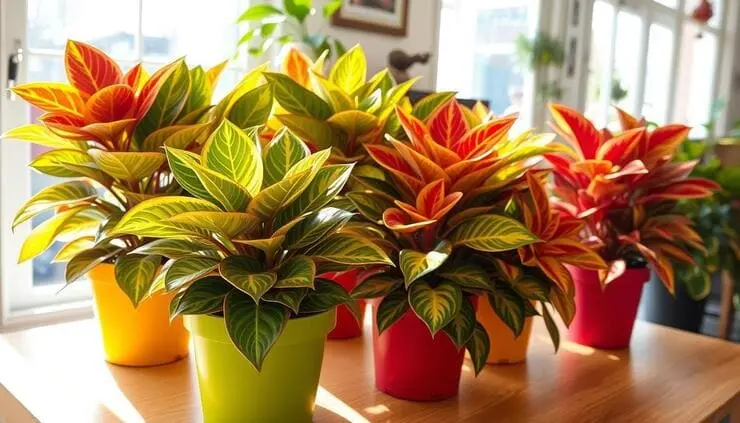
Crotons are truly eye-catching colorful indoor houseplants. Their bright, multicolored leaves can turn any room into a vibrant oasis. Their leaves show off a wide range of colors, from deep reds and oranges to bright yellows and greens.
To keep your croton’s colors bright, it needs the right light. They love bright, indirect sunlight. Place them near a window that gets lots of natural light but avoid direct sun.
Take good care of your croton to keep it looking its best. They need moist, well-draining soil. Water them often but avoid too much water. Fertilize every few months to keep their leaves vibrant. Also, keep the air around them moist by misting or using a pebble tray.
With proper care, your croton will keep you amazed with its colorful leaves. Follow these tips to enjoy their vibrant colors for years to come.
3. Calathea (Prayer Plant)

Calathea, also known as the Prayer Plant, is a standout among indoor plants. Its leaves move with the light, creating a mesmerizing effect. They close at night and open in the morning, earning the name “Prayer Plant.”
Calathea plants are famous for their eye-catching leaves. They come in a variety of colors and patterns that change with the day. You’ll see everything from bold stripes to vibrant greens, pinks, and purples, making them a stunning addition to any room.
Some top Calathea varieties include the Calathea Zebrina and the Calathea Ornata. The Zebrina has zebra-like patterns, while the Ornata has elegant pinstripes. The Calathea Medallion boasts a medallion design. Each variety has its own unique foliage, making them a favorite among colorful indoor houseplants lovers.
While Calathea plants require extra care, they can thrive indoors with the right attention. They need high humidity, consistent moisture, and bright, indirect light. By meeting these needs, you can enjoy their beautiful colors and leaf movements in your home.
4. Polka Dot Plant (Hypoestes Phyllostachya)
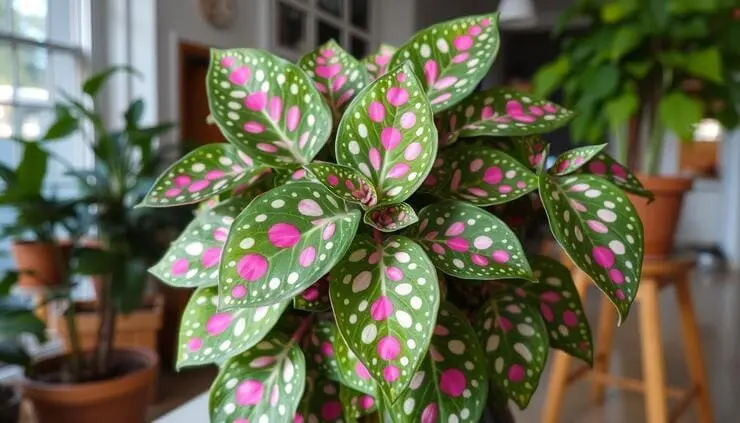
Looking to brighten up your indoor space? It has speckled leaves in pink, white, and red. This fun plant is easy to care for and adds a playful vibe to any room.
For your polka dot plant to do well, it needs the right light. It loves bright, indirect light, so a sunny window is perfect. But, direct sunlight can wash out its colors. Therefore, pick an area with lots of filtered light.
To keep your polka dot plant looking its best, follow a few simple steps. Don’t let the soil get too damp. Mist the leaves often to keep them happy. Feed it every two to three months to keep it growing strong and colorful. Prune any dead leaves to keep it looking full and healthy. With proper care, your polka dot plant will bring joy and beauty to your home.
5. Purple Passion Plant (Gynura Aurantiaca)
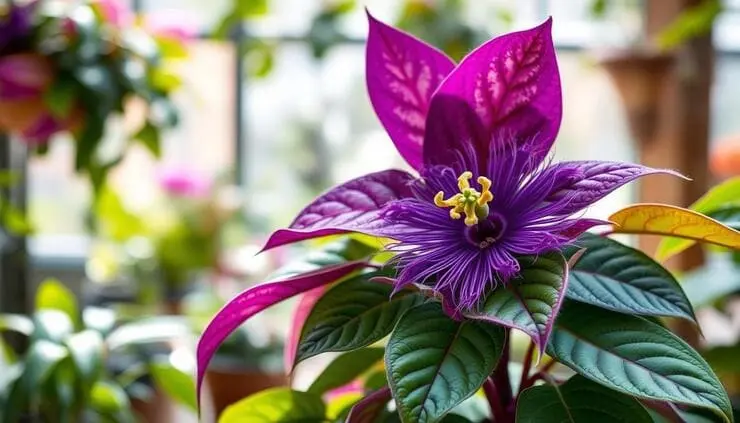
Looking to add whimsy to your indoor garden? The purple passion plant (Gynura aurantiaca) is perfect. Its fuzzy, purple leaves grab your attention. It stands out among other colorful indoor houseplants with its vibrant colors.
The purple passion plant’s leaves are its main attraction. They’re soft, fuzzy, and a beautiful purple-burgundy color. As the plant grows, the leaves get even more vibrant, making it a stunning sight.
To keep the purple passion plant’s colors bright, it needs the right care. It loves bright, indirect light. Make sure it gets plenty of sunlight. Also, keep it well-watered and in a humid environment to preserve its purple beauty.
The purple passion plant does best in a spot with good air flow and moderate temperatures. Aim for 65-75°F. Avoid direct sunlight to prevent fading or scorching. With the right care, your plant will thrive, showing off its unique colors.
RELATED : 13 Must-Have Décor Items to Brighten Your Home
6. Bromeliad

If you want a touch of the tropics indoors, bromeliads are perfect. These colorful indoor houseplants plants have bold colors and a unique shape. They can brighten up any room. You can find many varieties, like the fiery red Guzmania or the soft pink Aechmea.
Bromeliads are known for their striking look. Their leaves form a circle around the flower spike, making a beautiful focal point. The flowers come in many colors, from deep purple to bright yellow. They can give your house a more tropical vibe.
To keep your bromeliad looking good, you need to care for it. They prefer moderate humidity and bright, indirect light. Make sure to water them right, filling their central cup with water. With the right care, you’ll enjoy a beautiful bloom for months.
When picking a bromeliad, think about the size, color, and growth habits. Small Tillandsias are great for small spaces, while big Guzmania and Vriesea species make a statement. Learn about each type’s care to help your bromeliad thrive.
7. Snake Plant (Sansevieria Trifasciata) ‘Golden Hahnii’
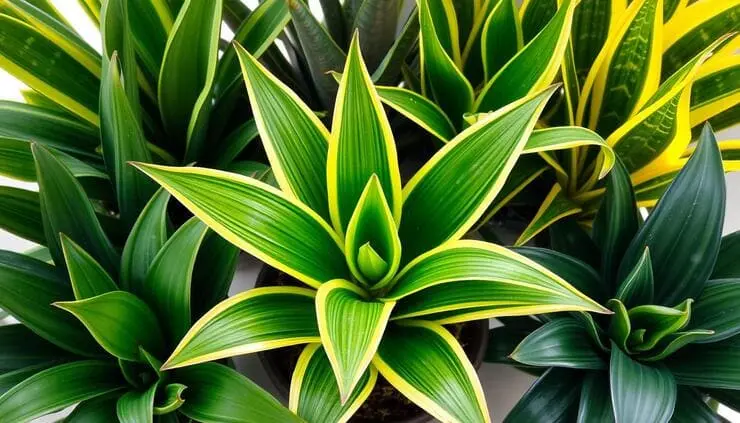
Meet the ‘Golden Hahnii,’ a stunning variety of the snake plant. Its lovely golden-tinged foliage provide any space a splash of color. This plant is easy to care for and perfect for adding color to your home.
The ‘Golden Hahnii’ snake plant has striking leaves with a golden-yellow hue. This adds warmth and elegance to its upright, sword-like foliage. It’s a great choice for those who want a colorful plant without overwhelming the space.
Snake plants, like the ‘Golden Hahnii,’ are known for their low-maintenance care. They can thrive in many conditions, making them perfect for busy people or beginners. Water them only when the soil is dry, and give them bright, indirect light to keep their colors vibrant.
For the best growth, place your ‘Golden Hahnii’ in bright, indirect sunlight. Avoid direct sun to prevent scorching. Grouping it with other colorful indoor houseplants, like crotons or calatheas, can create a stunning display.
8. Coleus
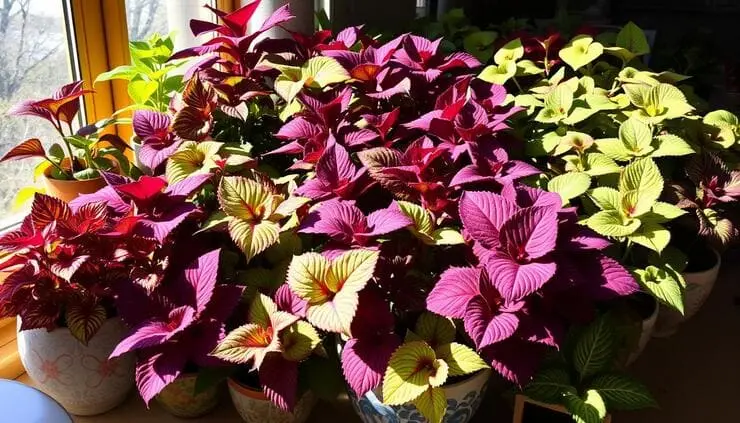
Coleus is a favorite indoor plant with its bright, colorful leaves. They come in many patterns and shades. You can find coleus in bold colors like red and green, or softer ones like purple and pink. These colorful indoor houseplants add color to your home and do well indoors with proper care.
To keep your coleus looking great, watch their light and water needs. They like bright, indirect light. Put them beneath a grow lamp or close to a window that gets lot of sunlight. However, to avoid leaf burn, stay out of direct sunshine..
For watering, keep the soil moist but not too wet. Water when the top inch of soil feels dry. This way, you avoid letting the soil dry out completely.
To make your coleus fuller and bushier, try a few tricks. Regularly pinch or trim the stem tips. This encourages more branches and a fuller plant.
Also, fertilize your coleus every two to three weeks. Use a balanced, water-soluble fertilizer. This supports healthy growth and bright leaves. Follow these tips for a stunning, compact coleus that thrives indoors.
9. Begonia Rex
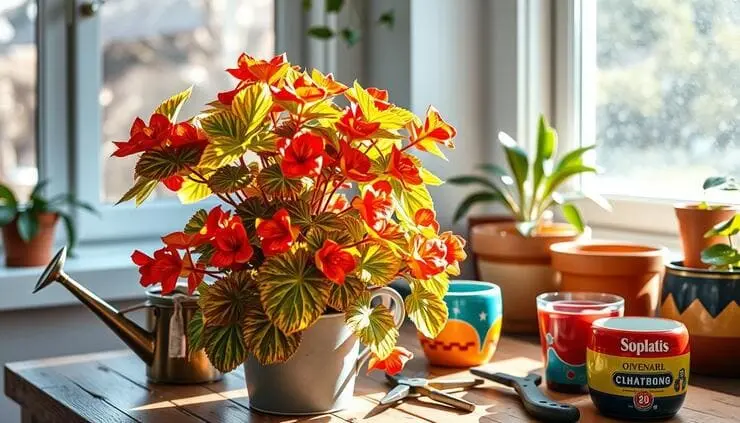
The Begonia Rex is perfect for adding vibrant color to your indoor garden. These plants have leaves that shine with colors like deep reds, purples, silvers, and greens. They can make any room look better and become a stunning centerpiece.
To keep your Begonia Rex happy, it needs the right conditions. It prefers well-draining, nutrient-rich soil and bright, indirect light. Water it when the top inch of soil feels dry, but don’t overdo it to avoid root rot. To maintain the proper humidity, mist the leaves frequently. Also, fertilize it regularly with a balanced liquid fertilizer to keep its colors bright.
Leaf browning or drooping is a common problem with Begonia Rex. It’s usually because of wrong watering or too much direct sunlight. Watch your plant’s moisture closely and adjust your watering. Put it somewhere that receives plenty of indirect light. Using a humidifier can also help keep the humidity just right. With proper care, your Begonia Rex will stay beautiful for years.
10. Fittonia (Nerve Plant)
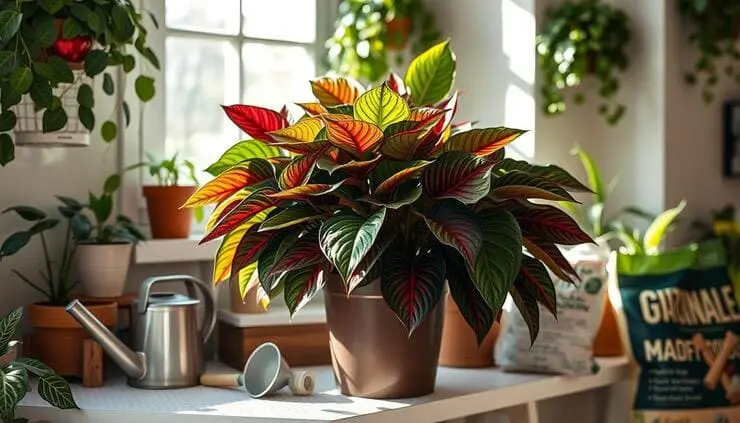
Introduce vibrant color and intricate foliage to your home with the Fittonia, or Nerve Plant. These small, trailing plants have stunning leaves in bright red, pink, and white. They make a great focal point or a lush addition to your plant collection.
The Fittonia’s standout feature is its striking leaf pattern. It has bright veins on a deep green background. These veins can be vibrant red, soft pink, or white, creating a mesmerizing effect.
To keep your Fittonia thriving, provide the right conditions. They love humid environments, so mist the leaves often or place them near a pebble tray. They also prefer bright, indirect light. Make sure the soil is consistently moist but avoid overwatering to prevent root rot.
The Fittonia’s unique foliage makes it a great match for other colorful indoor houseplants. Group it with plants like Calathea, Philodendron, or Peperomia. Its trailing habit looks beautiful from shelves or hanging baskets, creating a stunning display.
11. Orchid (Phalaenopsis)
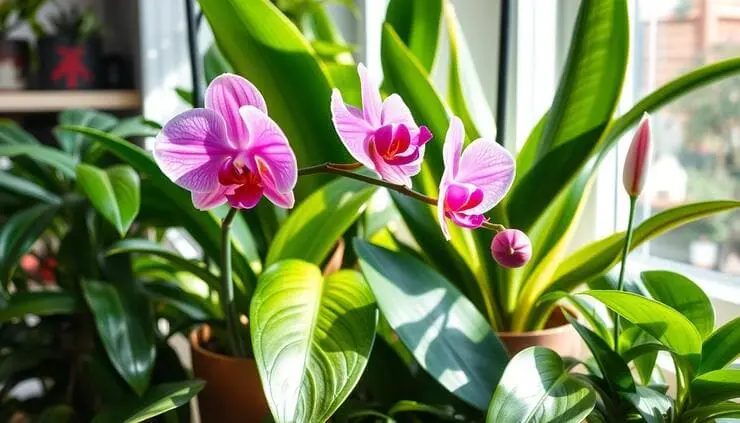
Orchids are amazing, with beautiful blooms in many colors. The Phalaenopsis, or Moth Orchid, is very popular. It brings a touch of tropical beauty to your home.
Phalaenopsis orchids have a wide range of colors. You can find them in white, pink, fuchsia, purple, and yellow. Their long-lasting flowers are perfect for adding beauty to your home.
To keep your Phalaenopsis orchid happy, give it the right care. They prefer moderate humidity and bright, indirect light. Make sure not to overwater, as the soil should dry a bit between waterings.
Place your Phalaenopsis orchid in a bright spot, like a windowsill. Avoid direct sunlight to protect the leaves. Keep the temperature between 65-85°F for the best results.
12. Zebra Plant (Aphelandra Squarrosa)
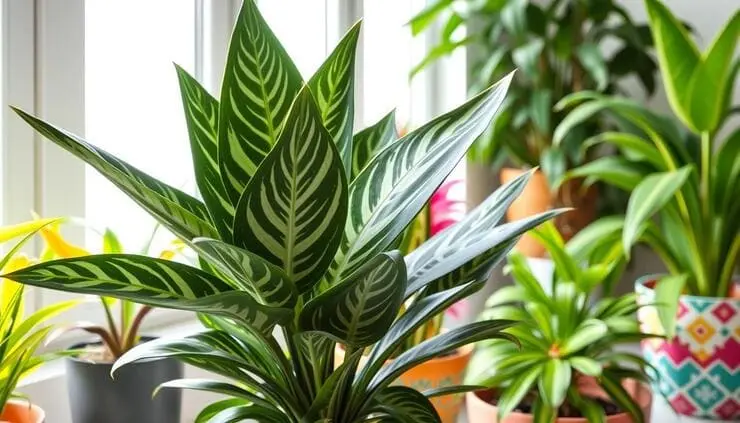
Bring a touch of the tropics to your indoor space with the striking Zebra Plant. This eye-catching houseplant boasts bright yellow blooms that contrast beautifully with its distinctive, striped leaves. The Zebra Plant’s bold foliage features dark green hues accented by vibrant yellow or white stripes, creating a captivating visual display that’s sure to liven up any room.
The Zebra Plant’s most notable feature is its unique leaf pattern. The large, oblong leaves showcase a series of parallel, yellow-to-white stripes running across the surface, resembling the distinctive markings of a zebra. When the plant is in bloom, it produces bright yellow, tubular flowers that add an extra pop of color to the already striking foliage.
To keep your Zebra Plant thriving, provide it with the right growing conditions. These colorful indoor houseplants prefer bright, indirect light, so place them in a spot that receives plenty of sunlight throughout the day. Zebra Plants also appreciate consistent moisture – water the soil when the top inch becomes dry, but be careful not to overwater. Maintaining proper humidity is key, so consider grouping your Zebra Plant with other colorful indoor houseplants or using a pebble tray to increase the moisture in the air around it.
While generally low-maintenance, Zebra Plants can sometimes encounter issues. Browning leaf tips or edges often indicate too little humidity, while yellowing leaves may signal overwatering. If your Zebra Plant’s leaves start to droop, it’s likely not getting enough light. By addressing these common problems promptly, you can help your Zebra Plant thrive and maintain its vibrant, eye-catching appearance.
In conclusion, each plant has its quirks and specific care needs, but with a little attention, they can thrive indoors, even in smaller spaces. By thoughtfully selecting and placing these colorful plants, you’ll find your rooms transformed into lush, joyful havens. A splash of greenery with these colorful selections is an easy and effective way to create a welcoming, uplifting environment in your home.

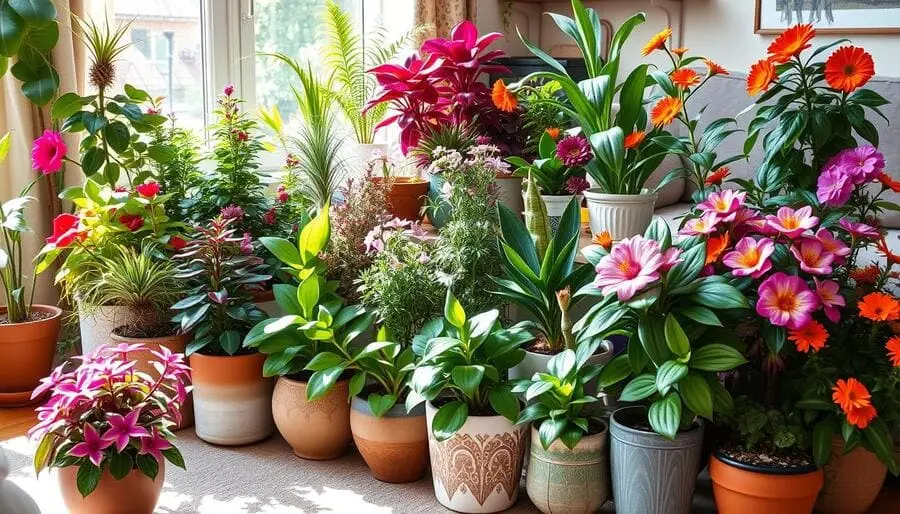
3 thoughts on “12 Top Colorful Indoor Houseplants to Cheer Up Your Home”